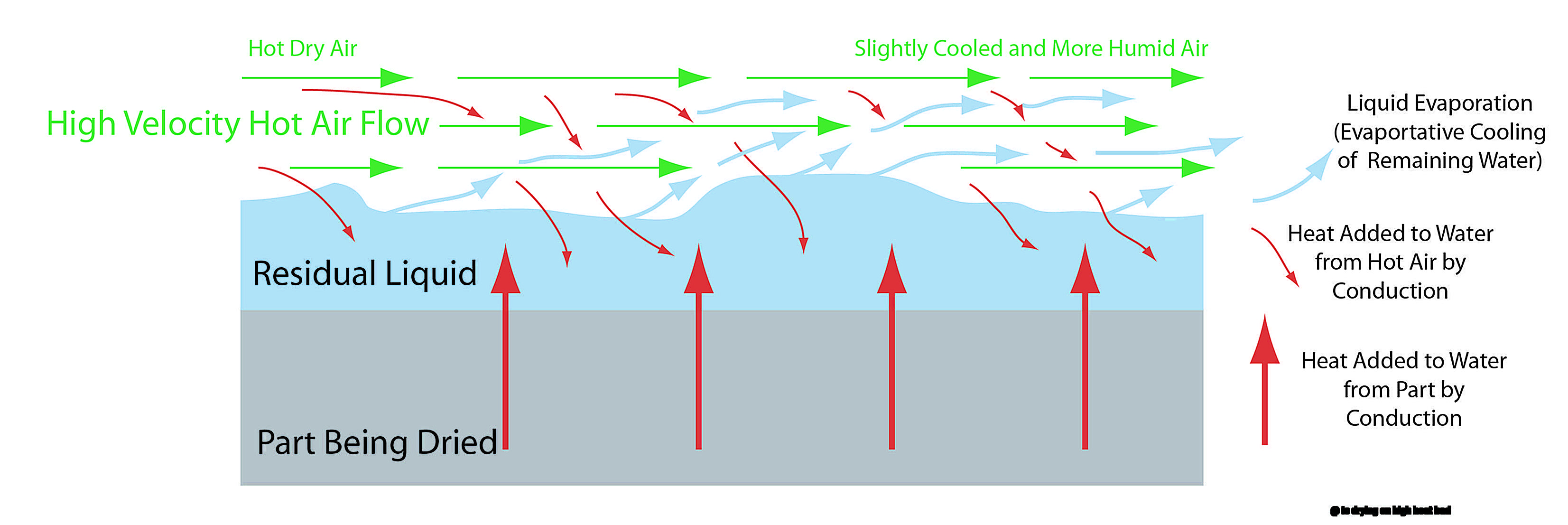
We’ve all been there, rushing to get our clothes dry and cranking up the heat on the dryer. But have you ever wondered if this quick fix is actually doing more harm than good? It’s time to dive into the world of drying clothes on high heat and uncover why it might not be the best idea. Brace yourself for potential fabric damage, increased shrinkage, energy inefficiency, and even environmental implications.
Using high heat while drying clothes can be a risky business. The excessive heat weakens the fibers in our beloved garments, leading to their eventual demise. Delicate fabrics like silk, lace, and wool are particularly susceptible to heat damage. Ever experienced that sinking feeling when your favorite sweater comes out of the dryer two sizes too small? Yep, that’s what happens when you blast it with excessive heat.
But wait, there’s more. High heat also means increased shrinkage. The fibers in your clothes tighten under the scorching temperatures, causing them to shrink in size. This can turn your once-perfect jeans into an uncomfortably tight squeeze or make that form-fitting dress impossible to slip into. Who needs that kind of frustration?
And let’s not forget about energy consumption. Drying clothes at high temperatures eats up more electricity and strains your household resources. Your wallet won’t be happy when those hefty electricity bills roll in either. By opting for lower temperatures or alternative drying methods like air-drying or using the dryer’s gentler settings, you can reduce your energy consumption and leave a smaller carbon footprint.
In conclusion, while it may seem tempting to rely on high heat for speedy drying, we can’t ignore the potential risks involved. From damaging our precious fabrics and increasing shrinkage to wasting energy and harming the environment, drying on high heat has its downsides. It’s time to consider alternative drying methods and adopt a more gentle approach to preserve our clothes, save energy, and promote sustainable living. So next time you reach for that dryer dial, think twice before cranking up the heat.
Is drying on high heat bad
Contents
- 1 Is drying on high heat bad
- 2 How High Heat Drying Causes Shrinkage and Damage to Fabric
- 3 Weakening of Fibers in Fabric due to High Heat Drying
- 4 Risk of Color Fading with High Heat Drying
- 5 Impact on Energy Bills from High Heat Drying
- 6 Delicate Fabrics Not Suitable for High Heat Drying
- 7 Tips for Avoiding Damage from High Heat Drying
- 8 Benefits of Air-Drying Clothes Instead of Using a Dryer
- 9 Conclusion
We’ve all been there – you’re in a rush and need your clothes dried as quickly as possible, so you crank up the heat on your dryer. While it may seem like a convenient and time-saving solution, drying on high heat can actually be detrimental to both your clothes and the environment. Let’s explore why.
Damage to Clothing
When subjected to high temperatures, fabrics can suffer from shrinkage, fading of colors, and weakening of fibers. Delicate fabrics such as silk or wool are particularly vulnerable and may not be able to withstand the heat. Imagine pulling your favorite wool sweater out of the dryer only to find it has shrunk to doll-size. Not a pleasant sight, right?
Excessive drying caused by high heat can also leave your clothes feeling stiff and uncomfortable. The natural moisture and oils in the fabric are stripped away, making it more prone to wrinkles and static cling. Nobody wants to wear a shirt that feels like cardboard.
Risk of Fire
Another concern with drying on high heat is the increased risk of fire. Lint build-up in dryer vents or lint traps can become a fire hazard when exposed to high temperatures. It’s important to regularly clean these areas to prevent potentially dangerous situations.
Environmental Impact
Aside from damaging your clothes, drying on high heat also has negative environmental impacts. High heat settings consume more energy, leading to higher electricity bills and increased carbon emissions. By opting for lower heat settings or air-drying methods, you can reduce your energy consumption and environmental footprint.
Alternatives to High Heat Drying
To mitigate potential damage caused by high heat, there are several alternatives you can consider. Using lower heat settings in your dryer or air-drying your clothes can help preserve their integrity. You can also try using dryer balls or adding a clean towel to the load to speed up drying time without the need for high heat.
It’s important to note that not all fabrics are created equal, and some may be more resilient to high heat than others. Always check the care instructions on clothing labels before subjecting them to high heat in the dryer.
How High Heat Drying Causes Shrinkage and Damage to Fabric
Drying our clothes quickly is a common desire, but it’s important to understand the potential consequences of using high heat. In this blog post, we’ll explore why high heat drying can lead to shrinkage and damage to fabric. We’ll dive into the science behind it, discuss the different impacts on natural and synthetic fibers, and provide practical tips to prevent these issues. So, grab a cup of tea and let’s unravel the truth about high heat drying.
The Science Behind Shrinkage:
When fabric is exposed to high temperatures, its fibers undergo significant stress. This stress weakens the fibers and reduces their elasticity, making them more prone to shrinkage. Natural fibers like cotton, wool, and silk are particularly susceptible to shrinking when exposed to excessive heat due to their composition and structure.
Table 1: Shrinkage susceptibility of different fabrics
Fabric Type | Shrinkage Susceptibility
——————————————
Cotton | High
Wool | High
Silk | High
Polyester | Medium
Nylon | Medium
Damage Beyond Shrinkage:
Shrinkage is not the only concern with high heat drying. The excessive temperature can also damage the fabric itself. The heat breaks down the fibers, making them brittle and susceptible to tearing. This can result in fraying or even holes in your favorite garments.
Understanding Synthetic Fabrics:
While synthetic fabrics like polyester and nylon may not shrink as much as natural fibers, they are still vulnerable to deformation under high heat. Excessive temperatures can cause these materials to lose their shape and fit, leaving you with ill-fitting clothes or misshapen textiles.
Tips for Preventing Shrinkage and Damage:
To minimize the risk of shrinkage and damage from high heat drying, here are some practical tips:
- Follow Care Instructions: Always refer to the care instructions provided by the manufacturer. They often include recommended drying temperatures for the specific fabric or garment.
- Low or Medium Heat Settings: When in doubt, opt for lower heat settings on your dryer. This gentler approach can help preserve the integrity of the fabric and reduce the likelihood of shrinkage or damage.
- Air Drying: Consider air drying your clothes instead of using high heat. This method is not only gentle on fabrics but also energy-efficient and environmentally friendly.
Weakening of Fibers in Fabric due to High Heat Drying
The Heat is On: Understanding the Damage
When fabrics are exposed to high heat during the drying process, the fibers can suffer a brutal blow. Natural fibers like cotton and wool are particularly vulnerable, as they are more prone to heat-related damage. The intense heat can cause these fibers to shrink, warp, or even melt, resulting in weakened fabric integrity. The once-strong fibers become thin, brittle, and susceptible to tearing. Not exactly the fate you want for your beloved garments, right?
Moisture Meltdown: Say Goodbye to Comfort
High heat drying also saps the moisture from fabric fibers, leaving them parched and prone to breakage and fraying. Imagine slipping into a shirt that feels rough and uncomfortable against your skin. No thanks. It’s clear that high heat drying robs fabrics of their natural moisture content, further weakening their structure and compromising their comfort.
The Battle of the Fibers: Natural vs. Synthetic
Not all fabrics are equally affected by high heat drying. Synthetic materials like polyester and nylon tend to be more heat-resistant and less susceptible to damage compared to natural fibers. However, even these resilient fabrics can suffer from extended exposure to high temperatures. The excessive heat can cause them to lose shape or develop permanent wrinkles – not exactly the polished look you were going for.
Protecting Your Precious Fabrics: Tips and Tricks
To preserve the quality and longevity of your fabrics, it’s best to avoid high heat drying whenever possible. Instead, opt for lower temperature settings or air-drying methods to protect the integrity of the fibers. But if high heat drying is unavoidable, fear not. You can still take precautions to minimize damage. Use protective barriers like dryer sheets or laundry bags to create a buffer between the fabric and the heat source, reducing direct exposure.
Understanding the risks and consequences of high heat drying empowers you to make informed decisions when caring for your fabrics. By adopting alternative drying methods and taking precautions, you can extend the lifespan of your clothes, keeping them looking fresh and feeling comfortable for years to come.
Risk of Color Fading with High Heat Drying
Did you know that high heat drying can be a major culprit behind color fading? In this blog post, we’ll dive into the nitty-gritty details of why your favorite shirt or dress loses its luster and how you can prevent it. So, let’s get started.
Understanding the Risks:
Breakdown of Dyes:
When fabrics are exposed to high temperatures, the dyes used in their production can break down, resulting in color fading. This risk is particularly prominent for delicate or brightly colored garments.
Fabric Sensitivity:
Natural fibers like cotton, silk, and wool are more prone to color fading. Synthetic materials such as polyester also have their fair share of vulnerability when it comes to heat-induced color loss.
High Heat Drying Methods:
Using high heat drying methods like tumble drying on a high heat setting or using hot air dryers further exacerbates the risk of color fading. Prolonged exposure to high temperatures speeds up the fading process.
Tips to Preserve Colors:
Follow Manufacturer Instructions:
Always refer to the garment care instructions provided by the manufacturers. These guidelines often include recommended heat settings for drying and may suggest air drying for certain items.
Handle with Care:
Avoid using harsh laundry detergents or fabric softeners, as they contain chemicals that can strip away fabric dyes over time. Opt for gentle detergents and skip the softeners to preserve those vibrant colors.
Separate by Color:
Prevent bleeding and dye transfer between garments by segregating your laundry based on color. Wash dark colors together and avoid mixing them with lighter or white clothing.
Restoring Faded Colors:
If you notice any color fading after high heat drying, don’t panic. There are a few steps you can take to restore or revive the colors. Consider using color-safe bleach or dyeing the garment back to its original color. However, keep in mind that these methods may not always be successful, so prevention is truly key.
Now that you’re armed with all the knowledge about the risks of color fading with high heat drying, it’s time to take action and preserve those vibrant colors for longer. Remember, a little extra care can go a long way in maintaining the beauty of your clothes. So, bid farewell to faded colors and say hello to long-lasting vibrancy.
Impact on Energy Bills from High Heat Drying
Drying clothes on high heat may seem like a quick and convenient way to get laundry done, but it comes at a cost. In this blog post, we will explore the impact of high heat drying on your energy bills and provide you with tips to minimize its effects.
The Impact on Your Energy Bills:
Increased Energy Consumption:
When you set your dryer to a high temperature, it requires more energy to generate the heat needed to dry your clothes quickly. This increased energy consumption translates into higher electricity or gas bills for your household.
Substantial Monthly Utility Costs:
Regularly practicing high heat drying can lead to a noticeable increase in your monthly utility costs. The extra energy used during each drying cycle can add up over time, significantly impacting your budget.
Comparing Different Approaches:
Heat Settings:
Most modern dryers offer multiple heat settings, including low or medium options. By opting for lower temperatures, you can effectively dry your clothes while consuming less energy.
Drying Duration:
Avoid over-drying your clothes as it contributes to higher energy consumption. Remove them from the dryer once they are fully dry or slightly damp, not only saving energy but also extending the lifespan of your garments.
Fabric Considerations:
Certain fabrics like silk or wool are more vulnerable to high temperatures and may shrink or become damaged. To prevent additional costs from ruined clothes, consider using lower heat settings or alternative drying methods for delicate items.
Exploring Alternative Drying Methods:
Air-Drying Outdoors:
Utilizing natural sunlight and fresh air by air-drying your clothes outdoors is an energy-efficient option, especially in warmer climates or during sunny days. It eliminates the need for any electricity or gas usage.
Indoor Clothesline:
If outdoor drying is not an option, consider setting up an indoor clothesline. This method still utilizes natural air circulation and can be an effective alternative to high heat drying.
Delicate Fabrics Not Suitable for High Heat Drying
When it comes to laundry, not all fabrics are created equal. Delicate fabrics such as silk, lace, satin, and cashmere require special care to ensure they maintain their quality and longevity. One common mistake people make is subjecting these fabrics to high heat drying, which can lead to irreversible damage.
In this article, we will explore why delicate fabrics should not be subjected to high heat drying and provide tips on how to properly care for them.
Silk: Handle with Care
Silk is a luxurious fabric known for its softness and lustrous appearance. However, this delicate fabric is highly susceptible to heat damage. High heat can cause silk fibers to break, leading to a loss of luster and a rough texture.
To preserve the beauty of your silk garments, it is best to air dry them or use the lowest heat setting on your dryer. If you must use a dryer, consider using a mesh bag or pillowcase to protect the fabric from direct heat.
Lace: Fragile and Intricate
Lace is a delicate fabric with intricate patterns and small threads that require extra care. High heat can easily damage lace garments, causing them to lose their shape or even tear. To prevent this, it is recommended to air dry lace items or use the lowest heat setting on your dryer. Additionally, placing a towel or fabric between the lace and the dryer drum can help protect it from direct heat.
Satin: Preserve its Sheen
Satin is a smooth and shiny fabric that can easily be ruined by high heat drying. The heat can cause the fabric to lose its sheen and become dull. To keep your satin garments looking their best, it is recommended to air dry them or use the lowest heat setting on your dryer. If ironing is necessary, use a low temperature setting or place a cloth between the iron and the fabric to prevent direct heat contact.
Cashmere: Handle with Extra Care
Cashmere is a luxurious and soft fabric that requires special care. High heat can cause cashmere to shrink and lose its softness. To properly care for cashmere, it is best to air dry it flat on a clean towel or use the lowest heat setting on your dryer. Avoid wringing or twisting the fabric when removing excess water, as this can damage the delicate fibers.
In conclusion, delicate fabrics such as silk, lace, satin, and cashmere should not be subjected to high heat drying. The heat can cause these fabrics to shrink, lose their shape, or become damaged. By following the proper care instructions and avoiding high heat, you can ensure that your delicate garments remain in excellent condition for years to come.
Tips for Avoiding Damage from High Heat Drying
Drying your clothes after a good wash is an essential part of laundry day. However, using high heat when drying can lead to damage such as shrinking, fading, and weakening of fibers. But worry not. We have some fantastic tips to help you avoid these issues and keep your clothes looking fresh and new.
Choose the Right Heat Setting:
When it comes to drying your clothes, selecting the right heat setting is crucial. Many dryers offer different options, so opt for the lowest heat setting possible. This gentle approach will protect your fabrics from excessive heat.
Shorten the Drying Time:
Leaving your clothes in the dryer for too long can spell trouble. Remove them as soon as they are dry or slightly damp, and let them air dry completely. This will prevent over-drying and potential damage to your garments.
Separate by Fabric Type:
Different fabrics have different drying requirements. To prevent damage, separate your laundry by fabric type and weight. Delicate fabrics like silk or lace should be kept away from heavier items that can withstand higher temperatures, such as jeans or towels.
Try Dryer Balls:
Dryer balls or wool dryer balls are a fantastic alternative to traditional dryer sheets. These handy tools help separate and fluff up your clothes, reducing drying time and eliminating the need for high heat. Plus, they’re chemical-free and eco-friendly.
Hang Dry Delicate Items:
For delicate fabrics that can’t handle high heat, consider hang drying them instead. This method is especially beneficial for silk or wool garments that are prone to shrinking or fading. Hang drying will preserve their shape and color.
Clean Your Lint Trap Regularly:
A clogged lint trap restricts airflow in the dryer, causing it to work harder and generate higher temperatures. To maintain optimal drying performance and prevent overheating, clean the lint trap regularly.

Benefits of Air-Drying Clothes Instead of Using a Dryer
Look no further. In this article, we will explore the numerous benefits of air-drying clothes instead of using a dryer. Not only is it an environmentally friendly choice, but it also helps preserve the quality of your garments, saves you money, reduces the risk of shrinking or distorting clothes, eliminates the need for ironing, and is beneficial for people with sensitive skin or allergies.
Environmental Friendliness:
- Reduces energy consumption and carbon footprint.
- Contributes to a more sustainable lifestyle.
Preservation of Quality:
- Prevents wear and tear, shrinkage, and fading.
- Extends the lifespan of your clothes.
- Gentle drying without subjecting fabrics to harsh conditions.
Cost Savings:
- Eliminates electricity or gas consumption associated with dryers.
- Saves you money on utility bills in the long run.
Avoid Shrinkage or Distortion:
- Some fabrics are prone to shrinking or distorting in dryers.
- Air-drying ensures your garments retain their original shape and size.
Less Ironing:
- Air-dried clothes tend to have fewer wrinkles compared to those dried in a dryer.
- Saves time on household chores.
Sensitive Skin and Allergies:
- Dryer sheets may contain chemicals that irritate sensitive skin or trigger allergies.
- Air-drying eliminates exposure to these chemicals, reducing the risk of skin irritation or allergic reactions.
By choosing to air-dry your clothes instead of using a dryer, you not only contribute to a greener environment but also enjoy benefits such as longer-lasting garments, cost savings, reduced ironing time, and improved skin health. So why wait? Start air-drying your clothes today and experience the difference for yourself.
Conclusion
Drying on high heat can have detrimental effects on your clothes and the environment.
The intense heat can cause fabrics to shrink, fade, and lose their shape. It can also weaken the fibers, leading to premature wear and tear.
To protect your garments and reduce your environmental impact, it’s best to opt for lower heat settings or air-drying methods.


